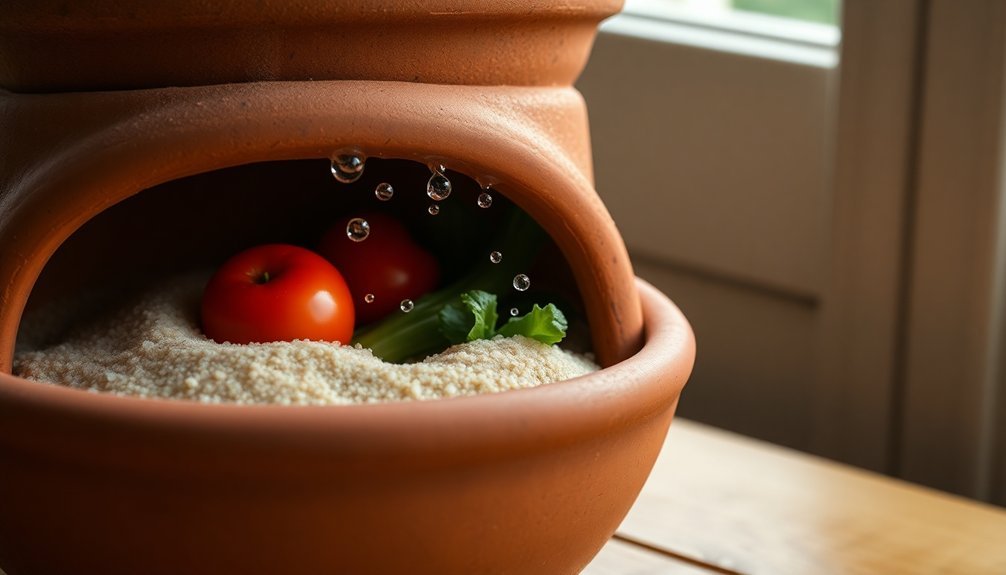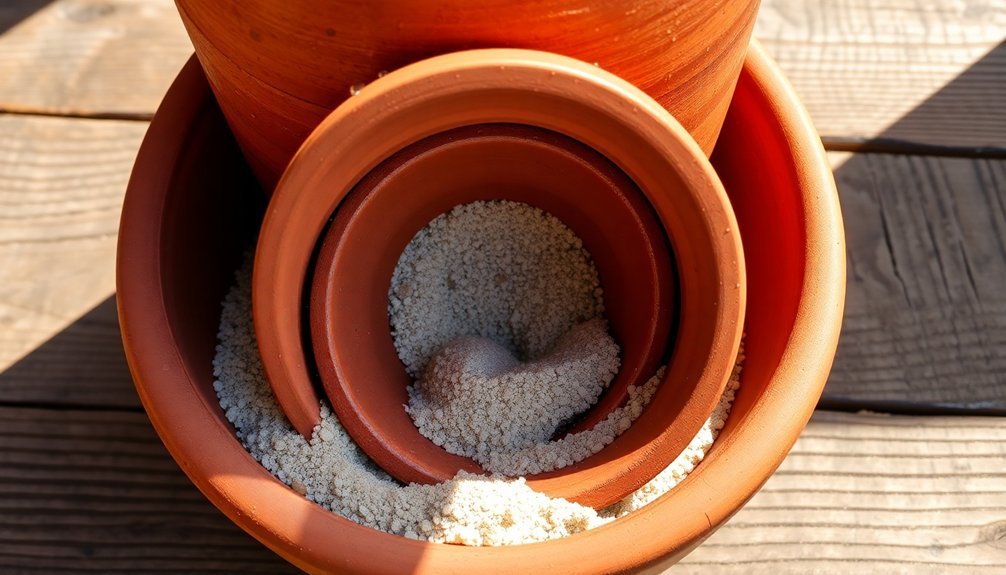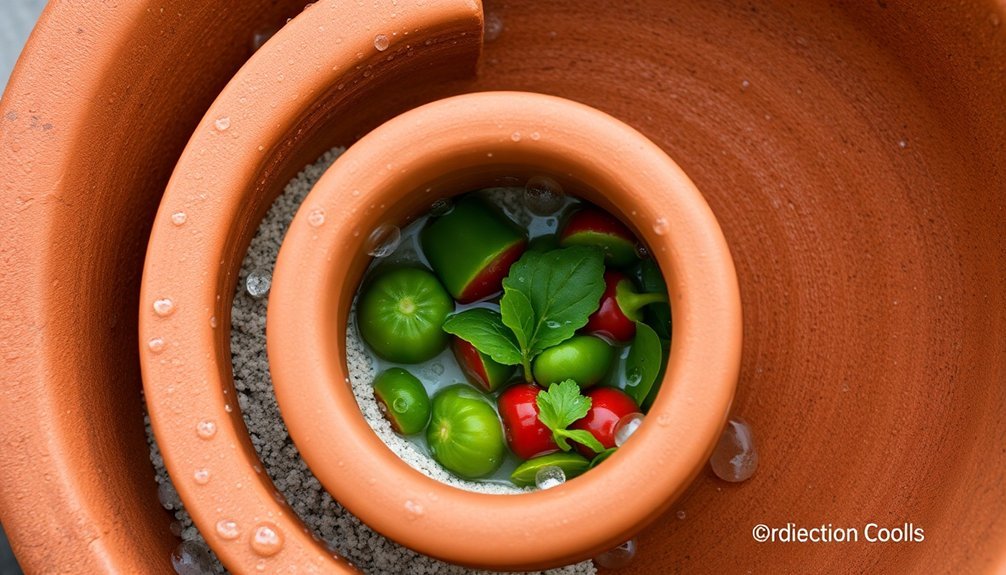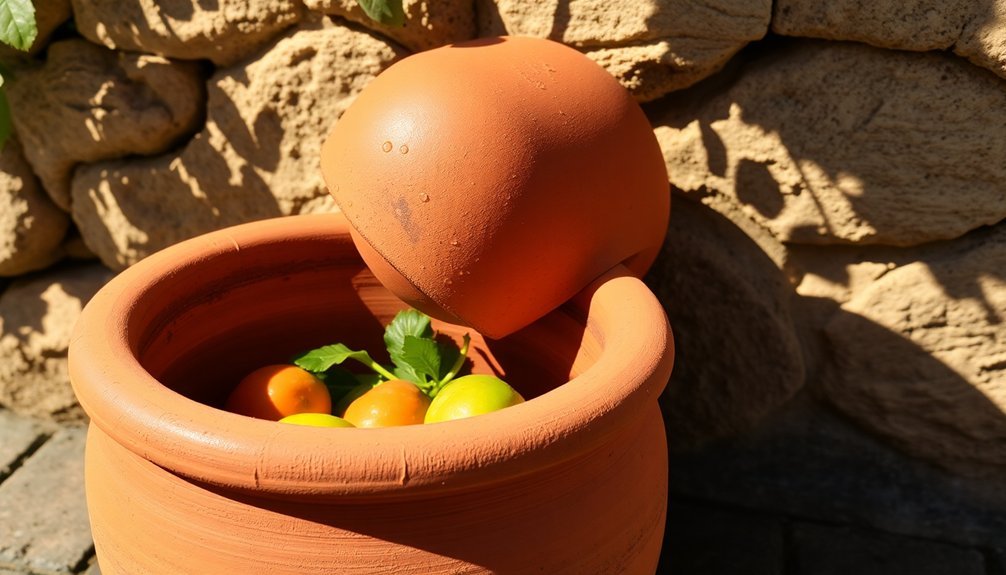Your clay pots stay cool through the clever science of evaporative cooling, similar to how sweating cools your body. When water evaporates from the unglazed clay walls and damp sand between two nested pots, it pulls heat away from the inside, creating a natural refrigeration effect. You'll notice temperatures can drop up to 10°C below the surrounding air, especially in low-humidity environments above 25°C. For best results, you'll want to place your clay pot cooler in a shady, well-ventilated spot and keep the sand consistently damp. There's much more to this ancient cooling method than meets the eye.
The Science Behind Clay Cooling

Clay pot cooling relies on the simple yet effective process of evaporative cooling, where water evaporating from the pot's outer surface draws heat from its contents.
This natural process works much like your body's cooling mechanism when you sweat – as water evaporates, it pulls heat away from the surface, creating a cooling effect.
You'll find that clay pots can reduce internal temperatures by up to 10°C below the surrounding air temperature, but they need specific conditions to work effectively.
The environment should have low humidity (less than 40%) and temperatures above 25°C.
You'll also need to place your pot in a shady, well-ventilated area to maximize its cooling potential.
The cooling efficiency depends on maintaining proper moisture levels, which means you'll need to add water one to three times daily.
Under ideal conditions, the temperature inside your pot can drop as low as the wet-bulb temperature.
While this cooling method isn't suitable for items requiring temperatures below 20°C, it's particularly effective for preserving vegetables and extending the shelf life of produce from one day to over four days.
This sustainable cooling solution has been especially impactful in Sub-Saharan Africa, where approximately 50% of harvested produce is typically lost to spoilage.
Building Your Clay Pot Cooler
Building an effective clay pot cooler starts with selecting the right components and assembling them correctly. You'll need two pots – a larger unglazed terra cotta container and a smaller pot that nests inside it, positioned about an inch from the rocks for ideal cooling. A glass pot lid can serve as an effective cover while allowing you to monitor stored items.
| Step | Action |
|---|---|
| Sealing | Apply silicone sealant to threads, nuts, and washers to prevent leaks |
| Assembly | Position inner pot, guaranteeing proper elevation with pot feet |
| Filling | Add 50 pounds of sand between pots, wet to brown sugar consistency |
| Covering | Place wet cloth over top and add decorative rocks to gutter |
To guarantee your cooler functions properly, you'll need to seal it thoroughly. Apply silicone sealant around the washer and bolt assembly, wiping away any excess, and let it cure for at least 3 hours. Once sealed, fill the gap between pots with dampened sand, being careful to keep it away from the washer and pot feet. For maintenance, keep your cooler in a shady, ventilated area and maintain proper sand moisture. Regular cleaning of the inner pot will prevent contamination and extend the shelf life of your stored produce.
Essential Materials and Setup

To successfully create your clay pot cooler, you'll need to gather the right materials before starting assembly. You'll require two unglazed clay pots of different sizes, coarse sand, a cloth or sack large enough to cover the smaller pot's mouth, water, and materials to seal any holes in the pots.
This ancient method has been used for millennia to preserve food without electricity.
Make sure the pots are clean and in good condition before you begin.
Start by adding sand to the base of the larger pot to create a level foundation for the smaller pot. Place the smaller pot inside and carefully fill the gap between both pots with sand, making sure none gets inside the smaller container.
Pack the sand until it reaches just below the top of the inner pot. You'll need to thoroughly wet the sand between the pots, but don't oversaturate it to the point of overflow.
The final step involves preparing the cloth cover. Dampen it thoroughly without making it drip, and fold it multiple times if needed to achieve the right thickness.
You can adjust the cooling effect by modifying how wet you keep the cloth and sand.
Optimal Environmental Storage Conditions
Success with your clay pot cooler depends heavily on choosing the right storage environment. You'll need to place your cooler in a location where temperatures stay between 40-70°F for ideal food preservation.
While the clay pot uses evaporative cooling to maintain humidity inside, you'll want to keep the external environment relatively dry to prevent excessive moisture that could promote bacterial growth or rust on any metal components.
Protection from direct sunlight is essential for your clay pot cooler's effectiveness. You should position it away from windows and heat sources, as sunlight can cause rapid temperature fluctuations that compromise food safety and quality.
Additionally, sun exposure can accelerate nutrient loss and cause oxidation in stored foods.
To maximize your cooler's performance, place it in a well-ventilated area that's elevated off the floor. This setup helps prevent pest infestations and reduces moisture exposure from ground contact.
Remember to monitor the storage conditions regularly and adjust the water levels in your clay pot system as needed. You'll also want to organize your stored items so that older foods are used first, maintaining proper food rotation practices.
Making Food Last Longer

Food preservation success hinges on proper use of your clay pot cooler's evaporative cooling system. You'll notice significant improvements in food shelf life when you store your produce correctly in these traditional devices. Your leafy greens can stay fresh for over four days instead of wilting after just one day at room temperature. Even better, some harvested crops can remain viable for up to 20 days when stored properly.
| Food Type | Regular Storage | Clay Pot Storage |
|---|---|---|
| Leafy Greens | 1 day | 4+ days |
| Tomatoes | 3-4 days | 15-20 days |
| Eggplant | 2-3 days | 12-15 days |
You'll benefit from reduced food waste and fewer trips to the market, saving both time and money. The pot's evaporative cooling mechanism maintains ideal humidity levels while reducing temperatures by up to 10°C below ambient conditions. This combination creates a perfect environment for preserving fruits and vegetables. To maximize these benefits, you'll want to guarantee the sand between the pots stays consistently moist and your cover cloth remains in place to maintain proper humidity levels.
Frequently Asked Questions
Can Clay Pot Coolers Be Used to Store Medicines and Insulin?
Yes, you can store medicines and insulin in clay pot coolers. They'll maintain suitable temperatures through evaporative cooling, but you'll need to monitor conditions carefully, change water regularly, and keep the pots in shaded areas.
What Traditional Cultures Have Historically Used Clay Pot Cooling Systems?
You'll find clay pot cooling was used by ancient Egyptians, Indus Valley civilizations, Mediterranean cultures (especially Spain), and North African societies. These systems remain popular in India, Pakistan, and parts of Africa today.
How Does Freezing Weather Affect the Durability of Clay Pot Coolers?
You'll need to protect your clay pot coolers from freezing, as trapped water can crack them. When water freezes, it expands, potentially breaking your pots. Keep them dry and sheltered during cold weather.
Can Multiple Clay Pot Coolers Be Stacked to Save Storage Space?
You shouldn't stack clay pot coolers since it reduces their cooling efficiency. Instead, use multiple smaller coolers side by side – they'll work better than stacked ones and maintain proper evaporative cooling performance.
Are There Specific Clay Types That Provide Better Cooling Performance?
You won't find specific clay types that are proven to cool better. The cooling effect depends more on the pot's porosity and design than clay type. What matters most is proper construction and maintenance.
In Summary
You'll find clay pot cooling to be a reliable, eco-friendly method for keeping food fresh without electricity. By using this ancient technique, you're taking advantage of natural evaporative cooling principles that can reduce temperatures by up to 30 degrees. Remember to maintain proper moisture levels and place your pot in a shaded, ventilated area. You've now got a sustainable way to preserve your food while reducing your carbon footprint.





Leave a Reply